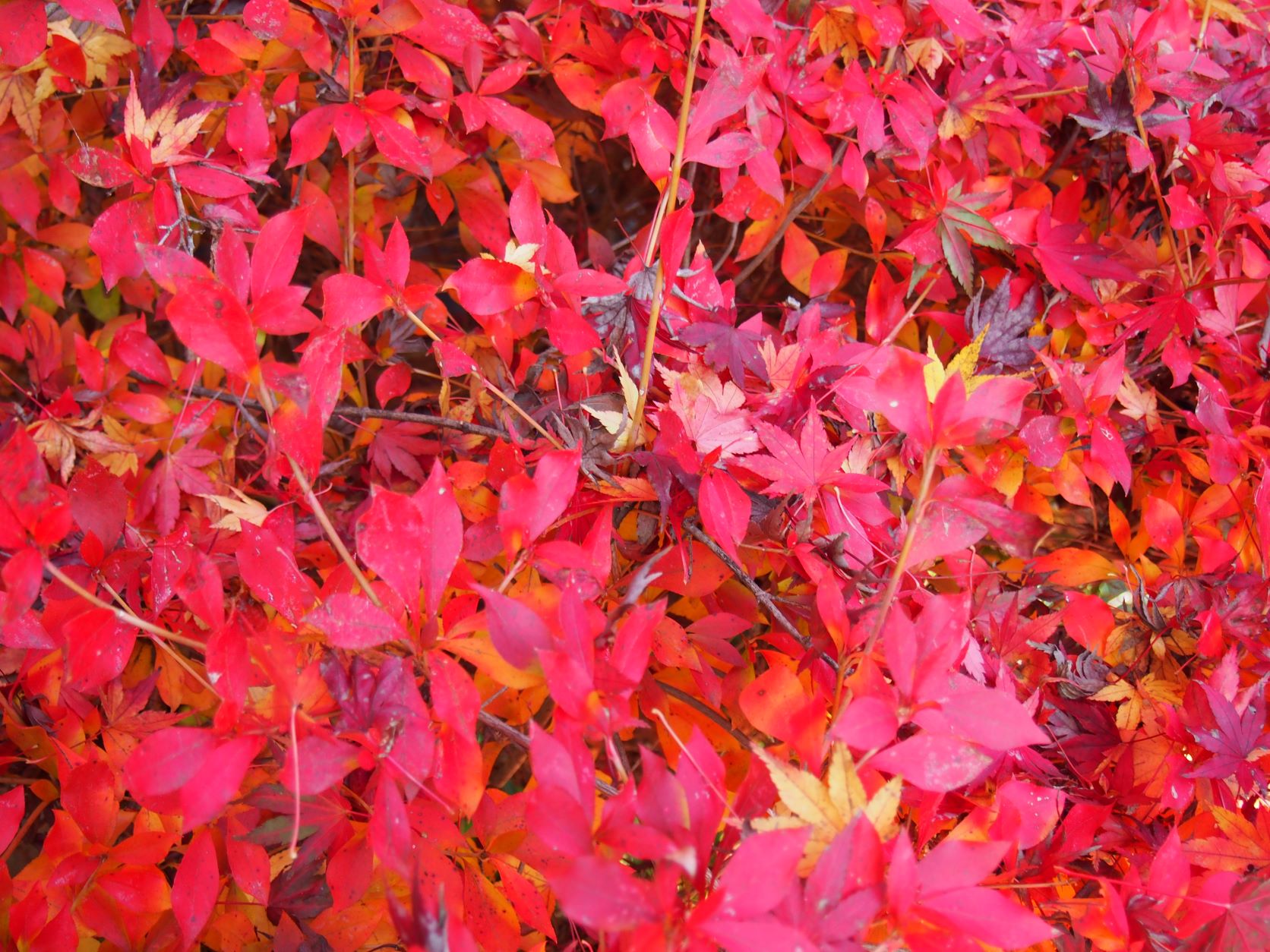There are numerous varieties of Japanese maples and you might be wondering which is the best for making bonsai.
Kotohime is the best Japanese maple bonsai because it has very small leaves with beautiful color and dense foliage. It is easily trainable as bonsai as well. Other species that are particularly good for bonsai include Kiyohime, Seigen and Shishigashira.
Japanese maple at a glance
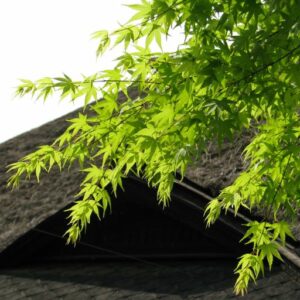
| Common name | Japanese maple |
| Latin name | Acer palmatum |
| Native area | Japan, Korea, China |
| Cold tolerance | High (14°F/-10°C) |
| Heat tolerance | High (100°F/37°C) |
| Drought tolerance | Fairly low |
| Sun exposure | High to partial shade |
| Soil mix | Akadama: 80% Sand: 10% Organic compost: 10% |
| Fertilization | Once each in Apr, May, Sept, Oct |
| Watering | Twice/day in spring and fall 3 times/day in summer Once every 2 days in winter |
| Life span | Well over 100 years |
Characteristics of Japanese maple as a bonsai

Strong
Japanese maple trees are very strong and can withstand hard pruning and defoliation to make trees smaller.
Round and smooth trunk
The trunk of Japanese maple trees is round and smooth. A beautiful striped pattern appears as the tree ages.
Good ramification
The tip of the Japanese maple’s branches can ramify finely.
Small, light, delicate leaves
The leaves of Japanese maple trees are neither too big nor too small. They are light and have very fine saw-like edges on the border, appearing delicate and beautiful.
Beautiful leaf color
The change in leaf color in fall is exceptionally beautiful.
Good surface roots (nebari)
The surface roots (nebari) of Japanese maple trees are one of the best among bonsai tree species, which make the tree look older and ancient as in nature.
The Best Japanese maple for bonsai
What’s needed for a good Japanese maple bonsai
Japanese maples (Acer palmatum) are native to Japan, Korea, and China and have a lot of varieties mainly thanks to human cultivation to enjoy their autumn leaves. As bonsai cultivars, there were more than 200 species before WWII in Japan, which is now reduced, but still a large number, to 50 or so varieties.
Of these, there are around a dozen that are commonly grown as bonsai since not all of them are ideal for bonsai. To be a good Japanese maple bonsai, it needs;
- To be able to grow small;
- Round and smooth trunk;
- Good ramification with fine, horizontal branches;
- Small, light, delicate leaves;
- Leaf color changes from beautiful green to bright red or vice versa; and
- Beautiful surface roots (nebari).
Kotohime is the best
Kotohime is the best Japanese maple bonsai because it has all the characteristics that a good Japanese maple bonsai needs.
Kotohime Japanese maple has one of the smallest leaves among Japanese maple trees and the foliage is thick and dense. Its leaf color is beautiful and elegant as well, enjoyable throughout the season. It is known to have very short internodes and has good ramification with fine branches, making it easily trainable as bonsai.
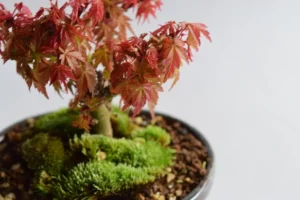
Maple-kotohime
Leaf description
| Leaf size | Very small |
| Leaf number | Dense |
| Leaf color (spring) | Green with a red-purple border to green |
| Leaf color (fall) | Bright red / yellow-orange |
| Leaf type | Simple |
| Leaf shape | Palmatisect (Having incisions that extend almost up) |
| Leaf margin | Lobed |
Branch description
- Good ramification
- Very short internodes
- Grow vertically
If you are thinking about growing a Japanese maple indoors, the following post may be of your help.
Other good Japanese maple for bonsai
There are a few good Japanese maples for bonsai, depending on what you are looking for, such as leaf shape and color or whether you want to make it a mini bonsai or a normal bonsai.
Here are some good Japanese maples you may consider growing.
Deshojo
Deshojo is noted for its leaf color, which changes from bright red in spring before maturing to green and then turning shades of red and orange in fall.
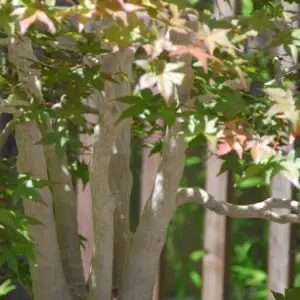
Deshojo maple in summer
Leaf description
| Leaf size | Small |
| Leaf number | Dense |
| Leaf color (spring) | Bright red tuning to green |
| Leaf color (fall) | Red/orange |
| Leaf type | Simple |
| Leaf shape | Palmatipartite (Having incisions that extend over halfway) |
| Leaf margin | Lobed |
Branch description
- Longer internodes
Kiyohime
Kiyohime is known to have very small and dense leaves. Branches grow horizontally and ramify toward their tips, making it a good candidate for a mini and rock bonsai.

Kiyohime maple
(Source: Yahoo Shopping Japan)
Leaf description
| Leaf size | Very small |
| Leaf number | Dense |
| Leaf color (spring) | Red turning to green |
| Leaf color (fall) | Bright red / orange |
| Leaf type | Simple |
| Leaf shape | Palmatisect (Having incisions that extend almost up) |
| Leaf margin | Lobed |
Branch description
- Good ramification towards the tip of the branches
- Produces lateral buds vigorously
- Grow horizontally
Seigen
Seigen is a very old cultivar dating back a few hundred years. Its new leaves are not green but brilliant red like burning fire.

Seigen maple in summer
Leaf description
| Leaf size | Small |
| Leaf number | Dense |
| Leaf color (spring) | Brilliant red to reddish green |
| Leaf color (fall) | Faded red |
| Leaf type | Simple |
| Leaf shape | Palmatisect (Having incisions that extend almost up) |
| Leaf margin | Lobed |
Branch description
- Rather thick branch
- Less ramification especially towards the tip of the branches
Shishigashira (Lion Head)
Shishigashira’s leaves are curly and dense, adding an interesting look to the tree.
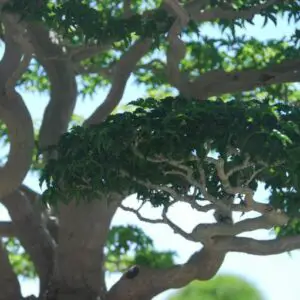
Shishigashira maple
Leaf description
| Leaf size | Small |
| Leaf number | Dense |
| Leaf color (spring) | Bright green / yellow-green |
| Leaf color (fall) | Scarlet red / orange |
| Leaf type | Curly |
| Leaf shape | Palmatisect (Having incisions that extend almost up) |
| Leaf margin | Lobed |
Branch description
- Rather thick branches
- Tend to grow vertically
Yama-Momiji
Native to Japan, Yamamomiji grows naturally all over the country. It is strong and easy to train and grow as a bonsai.
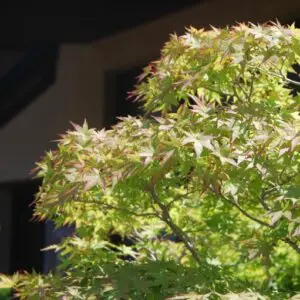
Acer palmatum subsp. matsumurae (Koidz) Ogata
Leaf description
| Leaf size | Medium |
| Leaf number | Dense |
| Leaf color (spring) | Bright green |
| Leaf color (fall) | Bright red |
| Leaf type | Simple |
| Leaf shape | Palmatipartite (Having incisions that extend over halfway) |
| Leaf margin | Lobed |
Branch description
- Good ramification
- Few branches elongate
※Yamamomiji is either Acer palmatum subsp. matsumurae (Koidz) Ogata or Acer amoenum var. matsumurae.
Yatsubusa
Yatsubusa has multiple layered foliages and is known for its beautiful leaf color.
Leaf description
| Leaf size | Small |
| Leaf number | Dense |
| Leaf color (spring) | Green |
| Leaf color (fall) | Bright red / orange |
| Leaf type | Simple |
| Leaf shape | Palmatisect (Having incisions that extend almost up) |
| Leaf margin | Lobed |
Branch description
- Good ramification towards the tip of the branches
- Grow horizontally

